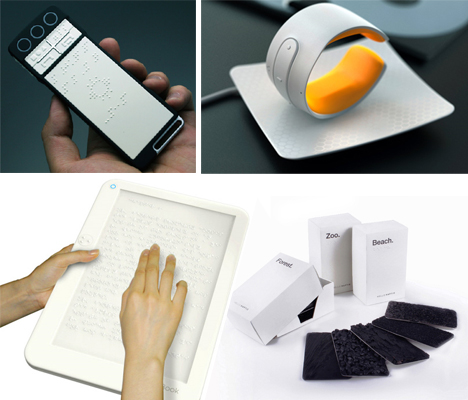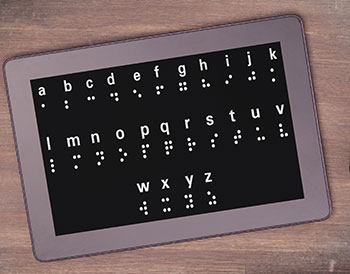A Guide to Life-altering Assistive Innovation for the Blind and Visually Impaired
The development of assistive technology has introduced a transformative period for people who are visually damaged or blind, offering devices that boost autonomy and enhance everyday experiences. Technologies such as smart navigating devices and AI-driven applications are redefining how individuals connect with their environments, while obtainable reading services and wise home innovations promise to more raise the high quality of life. As these technologies remain to progress, one should consider not just their performances but additionally their effect on fostering freedom and inclusivity. What does this mean for the future of availability?
Smart Navigation Devices
Smart navigation tools are reinventing the method people that are visually impaired or blind communicate with their atmosphere. These sophisticated modern technologies, which incorporate general practitioners, audio responses, and haptic signals, give users with critical information about their surroundings, enhancing their self-reliance and movement.
One popular example is the usage of smart canes equipped with sensors that spot obstacles and offer real-time feedback through resonances or audio signs. These devices permit users to navigate complex environments, such as active roads or crowded public areas, with boosted self-confidence. In addition, wearable tools, such as wise glasses, are being established to help in recognizing faces, reviewing message, and determining items, even more increasing the user's spatial awareness.
In addition, clever navigating devices are progressively incorporating fabricated intelligence to analyze information and adapt to customers' preferences. This customized approach not just enhances navigating performance but also fosters a feeling of empowerment among individuals. As technology remains to advancement, the potential for wise navigating tools to develop a more accessible and comprehensive globe for individuals that are aesthetically impaired or blind stays encouraging, ultimately improving their daily experiences and interactions.
Cutting-edge Mobile Apps
Mobile applications are arising as effective tools for helping people who are blind or visually damaged, using a variety of capabilities that enhance daily living. These apps harness progressed technology to assist in day-to-day tasks, enhance accessibility, and advertise freedom.
One category of ingenious mobile applications concentrates on visual recognition. Applications like Be My Eyes attach customers with sighted volunteers via video telephone calls, making it possible for real-time assistance for tasks such as reviewing tags or navigating unfamiliar atmospheres. Applications like Seeing AI use synthetic knowledge to describe environments, reviewed text, and determine items, offering individuals with vital details at their fingertips.
An additional significant location is navigating and orientation. Apps such as Aira and Close-by Explorer supply audio support, aiding customers browse metropolitan rooms effortlessly. They use tailored support, permitting an extra certain expedition of the atmosphere.
Furthermore, health and wellness and wellness applications provide to certain requirements, such as medication monitoring and health and fitness monitoring. These applications aim to foster a holistic strategy to wellness, guaranteeing that users can keep their health and wellness independently.
Wearable Assistive Gadgets
Wearable assistive devices stand for a considerable advancement in modern technology developed to sustain individuals that are blind or aesthetically impaired. These tools boost mobility and freedom by providing real-time responses concerning the surrounding setting. Amongst the most remarkable wearable innovations are clever glasses geared up with cameras and sensors, which can recognize obstacles and relay critical information with sound cues.

One more innovative alternative includes wrist-worn tools that use ultrasonic waves to find obstacles and give navigational help. These devices glasses for computer eye strain usually include customizable setups, enabling customers to tailor the alerts to their certain requirements.
The integration of fabricated intelligence in wearable pediatric eye care assistive modern technology is likewise significant, as it constantly boosts the accuracy and responsiveness of these tools. In general, wearable assistive tools are transforming the lives of the blind and aesthetically damaged, cultivating higher freedom and enhancing high quality of life via innovative options.
Accessible Checking Out Solutions
Obtainable reading services play a critical role in making it possible for individuals who are visually impaired or blind to involve with message across different formats. These options encompass a series of innovations and devices made to enhance analysis experiences, from typical print materials to digital material.
One noticeable service is Optical Character Recognition (OPTICAL CHARACTER RECOGNITION) modern technology, which transforms published message into digital style, permitting customers to pay attention to or review the content using screen readers. Furthermore, specialized e-readers geared up with text-to-speech abilities use personalized analysis experiences, enabling users to adjust font sizes and background shades for boosted visibility.
An additional reliable approach is braille display screens, which give responsive responses by transforming electronic message into braille. This allows individuals to review touch, fostering greater freedom and accessibility to literary works. Mobile applications designed for reviewing checked papers or books can equip users with instantaneous access to a vast collection of materials (Voice-activated assistive devices).

Smart Home Technologies
Smart home innovations have transformed the way individuals that are blind or aesthetically damaged communicate with their living atmospheres, enhancing both independence and safety. These cutting-edge remedies utilize automation and connection to produce an available space tailored to the demands of customers.
Smart audio speakers and voice-activated assistants provide hands-free control over numerous tools, enabling users to readjust lights, temperature, and safety and security steps via basic voice commands. This functionality decreases reliance on sighted assistance and promotes a sense of freedom. Additionally, clever lighting systems can be tailored to deliver acoustic feedback or responsive cues, making it possible for individuals to browse their homes better.
Additionally, protection systems furnished with smart cams and sensing units can send real-time signals to users, boosting personal security without demanding visual verification. Automated door locks offer assurance, permitting individuals to safeguard their homes effortlessly.
Incorporating clever home technologies not just boosts daily living however additionally encourages social communication via connected gadgets - AI-powered visual aids. With recurring developments in assistive innovation, the future shows up promising, as more options will certainly arise to more encourage people that are blind or aesthetically damaged, ensuring link a more independent and inclusive way of life
Final Thought
In conclusion, the advancements in assistive modern technology for the visually damaged and blind stand for a considerable leap towards boosting self-reliance and high quality of life. Smart navigation devices, ingenious mobile applications, wearable devices, accessible analysis services, and smart home technologies jointly promote an inclusive setting. This combination of technology not just enhances mobility and day-to-day living however also encourages individuals to involve fully with their environments, promoting better autonomy and engagement in society.
Innovations such as wise navigation gadgets and AI-driven applications are redefining how individuals interact with their environments, while accessible analysis solutions and wise home technologies assure to more elevate the high quality of life. As innovation proceeds to advancement, the potential for wise navigating devices to produce a much more accessible and comprehensive world for individuals that are blind or visually damaged continues to be promising, ultimately reshaping their day-to-day experiences and interactions.
Wearable assistive tools stand for a considerable development in modern technology developed to sustain individuals who are aesthetically impaired or blind. Among the most noteworthy wearable modern technologies are clever glasses equipped with sensing units and cameras, which can identify challenges and relay vital details through audio cues.
Smart navigation tools, ingenious mobile applications, wearable gadgets, easily accessible analysis remedies, and clever home technologies collectively foster an inclusive environment.